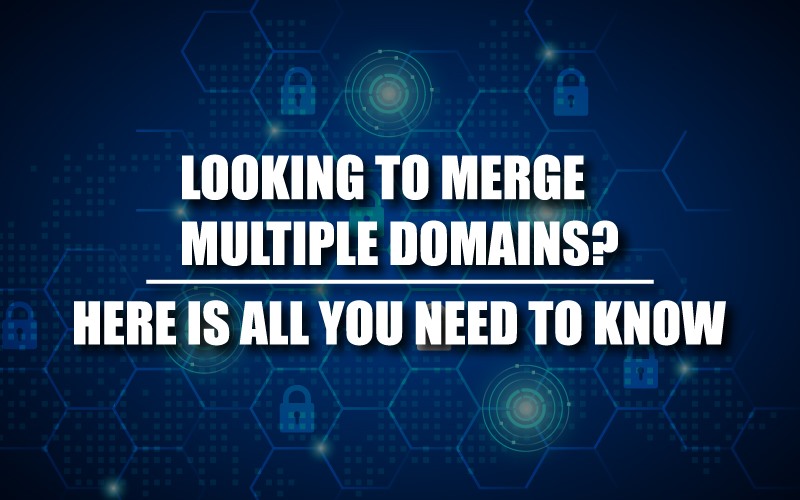Looking to merge Multiple Domains? Here is all you need to know.

If you happen to own more than one website, you might want to manage all of them with a single wildcard SSL Certificate. To serve this purpose, you will have to merge domains and fare with them through the same certificate. In such cases, merging multiple domains would save you additional headaches, cut down on the costs, and ease your security management.
As your business’s nature relies entirely on a customer, gaining their trust is of high pertinence. You may also be wondering, having multiple domains will demand you to purchase a personal certificate for each.
Merging multiple domains enables you to secure all of them under one certificate. And, this will take care of everything – be it tracking a multitude of vendors, licensing sources, or saving a considerable amount of your time and business. If you wish to know more about the wildcard SSL certificates and how they can be fruitful to you, here is the right blog for you. Let us get started.
What we will be covering today:
- What is an SSL Certificate?
- Types of SSL Certificates
- Types of SSL Validation
- How to Handle SSL Certificates While Merging Multiple domains?
- How Encryption works for Multi-Domain Certificates

What is an SSL Certificate?
SSL is an abbreviation for Secure Socket Layer. The SSL Certificate is a license that is a must for safeguarding your sites from the clutches of getting hacked. Getting this will protect you from cybercrime of any kind – be it a phishing attack from a hacker, middle man trust issues, or any other insecurities. These certificates’ pivotal function is to ensure that the data you share stays encrypted between the user and the server.
All of your confidential information, such as your card credentials or transaction history, gets locked from getting any further misuse. This is the safest way to steer clear from cybercriminal activities and see that none of your data gets leaked. You may be asking yourself, how do you get to know where a site has been SSL certified or not? It is pretty simple.
All you need to do is look for the green padlock sign at the top of the page. This green lock should be there at the top left, right when the domain URL starts. This sign ensures the viewers that you have nothing to worry about. Your prime focus should be on the shopping spree and not on these security affairs. As this promises to take your online business to the next level of security, you grab the chance to win your customers’ trust.
This, in turn, translates to more conversions, sales, and revs up the revenue bar. You would also be glad to know that an SSL-certified site will now rank better when searched on Google. The Google algorithm has been designed so that it gives preference to the sites that have this certificate.
Types of SSL Certificates
- Wildcard SSL Certificate: The best part about a wildcard SSL Certificate is that getting this will safeguard a single domain and all the subdomains underneath it. If you have plans to merge domains, this should be your go-to. It works similarly as the regular SSL Certificate works to encrypt the server and browser connection. It’s just that it comes with a huge plus point to safeguarding your subdomains as well. Simply put, you can now protect unlimited sub-domains over unlimited servers with a cheap wildcard SSL certificate too. Further, this will also aid in saving you a fortune. Quite a deal, isn’t it?
- Single Domain SSL Certificate: As stated earlier, the thing with single-domain SSL Certificates is that they are permitted to protect a single domain. And as the name suggests, it cannot be used to safeguard additional sub-domains along with it. They help in securing a single domain, which could have both the www and non-www connotations. This will empower you to encrypt all the communications taking place inside and go against any data theft. In simpler words, it will bolster your overall security quotient and enhance customer trust as well.
- Multi-Domain SSL Certificate: As the name denotes, a multi-domain SSL certificate is used for various domains. Here they require a single certificate, but that can cover different domains. Also, the subdomains of the primary domain are secured with this sole certificate. These sub-domains here are technically identified as the Subject Alternative Names or SANs. On an additional note, they do not require a dedicated IP address for each of your hostnames. It is otherwise known as Unified Communications Certificate (UCC), or SANs. Getting this certificate, too, will help you save a ton on the budgetary compensations as well.
Types of SSL Validation
- Extended Validation Certificate: The Extended Validation SSL Certificates’ primary purpose is to check the user to use a specific domain name by undergoing a simple vetting process in the organization. Further, it will verify the physical, operational, and legal existence of the given user. This type of SSL validation can be formulated for all businesses – be it government or private agencies. As a consumer, if you wish to assert the highest form of authenticity, which keeps the chances of hacks at bay, this looks like an ideal solution for you.
- Organization Validated Certificate: The Organization Validation requires a manual vetting procedure. Here, the CA will connect with the organization and request to get an SSL Certificate. Further, the OV SSL Certificates will have the organization’s address, name, and trusted credentials in them. This renders an authentic face to the viewers, making it more trustworthy and the right pick.
If you are a big organization and have many customers, getting this is a must for you. Also, note that, before you are validated, you will be subjected to a nominal round of investigation. You will be required to submit a few proofs and will be asked a couple of questions for smooth monitoring of the process.
- Domain Validated Certificate: Getting this is said to be the easiest of all. This requires the least level of sternness involved. To get one of these, all you have to do as an organization is to prove that you control the domain. You can do this by altering the DNS record that is linked with the domain.
Alternatively, you may send an email to the CA conveying the same. Generally, this is seen as an automatic process and does not intervene with much manual work. Also, this type of validation is the cheapest of all. If you have a site with blogs or are building a portfolio site, this can be your chosen option.
How to Handle SSL Certificates While Merging Multiple domains?
If you have multiple website domains, it is needless to say that it has thousands of multiple operations that can seamlessly drive you crazy. Merging multiple domains can pull your pieces back together.
When you begin consolidating multiple domains, all the links and the infrastructure of all these domains club together; further, this will help manage all domains with a single certificate. Here are two such solutions that you can easily carry out to marge domains while handling the SSL certificates:
- Keep the SSL Certificate live on all the domains: A browser looks for the certificate’s validity at first sight. Once this has been verified, it will opt for a redirect. If you have already deleted the old certificate, the algorithms of Google might find this apprehensive about understanding and taking a backseat from validating this migration.
It must be noted that the browsers need an SSL Certificate while redirecting. In most cases, the search engine should handle this, but show the certificate to your viewers if the need arises. And secondly, keep paying up for the old SSL Certificate as well.
- Keep the old certificate for six months: By now, you should be aware of the fact that Google re-crawls the URL two times a year. That means, every six months, your site will crawl back to the search engine.
That is why some have advised the industry experts that you keep the old certificates for at least six months. If you do no good, you cut down the chances of getting a cyber-attack in the very least. This will help you to avert the scams and save your site too.
How Encryption works for Multi-Domain Certificates

As long as you have gotten an SSL Certificate from a secured site, you do not have to worry about your user’s information at all. The second a website server interacts with a browser, they carry out a technical function called the SSL Handshake. This handshake makes sure that the encoding and decoding (or Encryption and decryption) of all the data is done in the right manner, just the way the user sends it. Till the data reaches the right source, it scrambles it to make it undecipherable in the meanwhile.
During this process, the browser will also ensure that the site’s SSL certificate has been validated. A secure connection will be built using the server’s private key and the client’s public key on reaching this note. This technical term is referred to as the session key, which makes the connection secure and unhackable.
Also, note that the very second a hacker sees that your site is not encrypted, they jump on to it to suck information without wasting any time. Therefore, if you wish to prevent any misuse of your data and the consumer’s precious data, you must see that each of the sites is encrypted and secure. To understand this better, it is vital to know the difference between some of the terms, such as:
- UCC Certificate vs. Wildcard Certificate: The main difference between the terms is that the UCC certificates can safeguard multiple subdomains and sub-domains. However, on the contrary, a wildcard certificate can only secure a sine domain and multiple sub-domains. The wildcard certificates need not be used explicitly in a computing milieu and can be attached with both the UCC certificates and the SAN certificates.
- Multi-Domain/SAN certificate vs. Wildcard certificate: While the Multi-domain certificates can safeguard numerous domains and subdomains, the wildcard certificates can only secure a single domain and numerous sub-domains, just like the one discussed above. On a similar track, neither of them needs a specific infrastructure, such as the Microsoft Office, to work in.
Conclusion
If you are the owner of significant e-commerce industry, then it is a given that you will have a couple of domains and subdomains to care about. In such cases, combining all the domains on every site and handling them together is always a good idea. This blog intends to walk you through the intricacies of having an SSL certificate and how to merge multiple domains. Hopefully, this would have helped you by throwing some light on the bits mentioned above. Now, you can seamlessly simplify your sites and can easily manage your domains.






